Birding in Spain: Birding in Catalonia Guided day tours, short breaks and holidays in the Cap de Creus. |
|||||||||||||||||
|
|
|||||||||||||||||
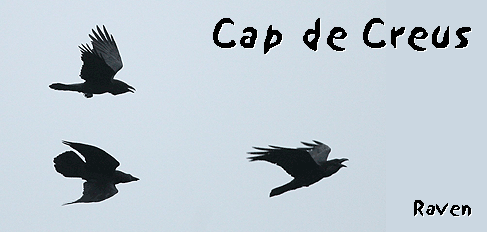 |
|||||||||||||||||
BIRD TOURS : |
TRIP REPORTS : |
EXTRA INFO : |
|||||||||||||||
Same-day Add-ons:
|
|||||||||||||||||
|
|
|||||||||||||||||
|
Photos by Zac Hinchcliffe, Stewart Abbott and other tour members. Balearic Shearwater by Mark Lewis. |
|||||||||||||||||
|
|
|
||||||||||||||||
Birding in the Cap de Creus : |
There are two reasons that make birding trips to this area the incredible experiences they so often turn out to be; the Cap de Creus Natural Park and the actual Cap de Creus itself.The former, only established in 1998, is Spain's only sea-land nature reserve, contains its largest uninhabited area and forms its most easterly point, all factors contributing to a startling array of bird migrants taking cover in its scrub, cliffs and crevices each spring and autumn. The park also provides a refuge for breeding Bonelli's Eagle, Spectacled and Western Orphean Warblers, Rock Thrush, Ortolan Bunting, Wryneck and Pallid Swift.And as for the Cap de Creus itself (Cabo de Creus in Spanish), there's almost guaranteed sightings of shearwaters, Shag, Gannet, auks and other seabirds throughout the year, which can be transformed - given the right timing and weather - into a miraculous show of oceanic activity that makes this the best land-based spot for close-on pelagic birds in the whole of Europe. Read more... |
Cap de Creus Birding Tours: |
|||||||||||||||
! Lunch !An excellent full home-made picnic based on local cuisine is available at €10 per person |
Cap de Creus onlyCap de Creus +
|
||||||||||||||||
Bird Tour Checklist: |
|||||||||||||||||
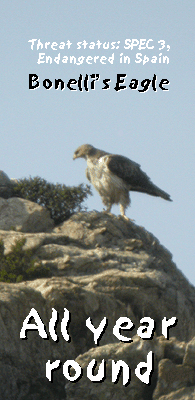 |
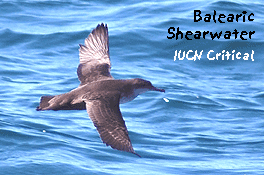 |
||||||||||||||||
Birding in the Cap de Creus:
|
All year round :
Yelkouan Shearwater (NT) Balearic Shearwater (cr) Northern Gannet (2) desmarestii Shag (vu) Red-legged Partridge (2) Sparrowhawk Common Buzzard Bonelli's Eagle (3) (en) Common Kestrel (3) Peregrine Falcon (3) Yellow-legged Gull Rock Dove/Feral Pigeon Wood Pigeon Collared Dove Eagle Owl (3) Little Owl (3) Iberian Green Woodpecker (2) Crested Lark (3) Thekla Lark (3) Woodlark (2) Crag Martin White Wagtail Wren Robin Black Redstart Stonechat (3) Black Wheatear (3) Blue Rock Thrush (3) Blackbird Song Thrush Cetti's Warbler Fan-tailed Warbler Blackcap Dartford Warbler (2) Sardinian Warbler |
||||||||||||||||
|
|
|||||||||||||||||
|
|
|||||||||||||||||
Such an expanse of uninhabitated, almost treeless mountain scrub is quite rare in Europe, perfect for those birders wanting a little vacational challenge on their Spanish birding trips.But an easier time can be had along its borders, where birds can be found saturated in coastal cliffs and islands, cork oak and pine woods, vineyards and olive groves.And arrive at the lighthouse in time to catch homebound fishermen and, weaving between the wake of gulls behind their boats, you can easily pick out the majestic gliding Balearic and Yelkouan Shearwaters - with recent times even bringing in the odd rarer pelagic wanderer. |
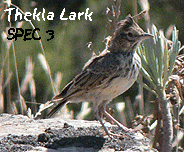 |
||||||||||||||||
|
|
|||||||||||||||||
|
|
|||||||||||||||||
|
|
|||||||||||||||||
"I could not have hoped for a better bird guide or company. Stephen obviously knows his birds but as important to me was the fact that he is easy to get on with, passionate about the area he birds in and very keen to give you the customer what you want."Phil Hardwick, Wales, October 2007 |
 |
||||||||||||||||
| Firecrest Long-tailed Tit Crested Tit (2) Blue Tit Great Tit Short-toed Treecreeper Southern Grey Shrike (2) (nt) Magpie Jackdaw Raven Starling (3) House Sparrow (3) Tree Sparrow (3) Rock Sparrow Chaffinch Serin Greenfinch Goldfinch Linnet (2) Common Crossbill Cirl Bunting Rock Bunting (3) Corn Bunting (2) Passage Only : Great Northern Diver Great Shearwater (V) Sooty Shearwater (V) Black Kite (3) (nt) Red Kite (2) (NT) Goshawk Honey-buzzard Marsh Harrier Booted Eagle (3) Hobby (nt) Arctic Skua Pomarine Skua Mediterranean Gull Little Gull |
|||||||||||||||||
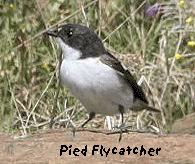 |
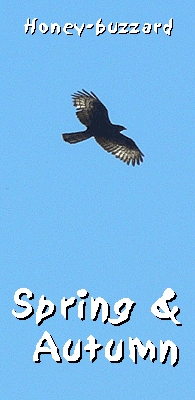 |
||||||||||||||||
Birding in the Cap de Creus: Spring and Autumn Passage |
|||||||||||||||||
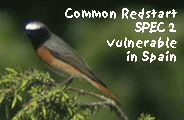 |
|||||||||||||||||
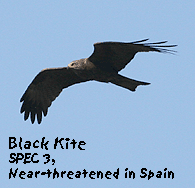 |
The Cap de Creus is one of Europe's favourite migration spots, a not-surprisingly popular destination for birding vacations and day trips alike when you consider how this part of Spain thrusts itself into the Mediterranean.In spring and autumn take your pick of the passerines lining the paths and clearings alongside the park's meandering roads. Many are breeders in transit but some, like Red-backed Shrike, are just passing through.Red Kite, Booted Eagle and Honey-buzzard are typical of the raptors that soar across its skies and Gannet, Cory's Shearwater (together with Balearic and Yelkouan) are amongst the seabirds that concentrate at its head. |
||||||||||||||||
| Spain birding: Cap de Creus: Spring and Autumn itinerary | |||||||||||||||||
"The trip was as great as I hoped it would be. I have assured my birding friends what a great time they'd have in NE Spain. I'm off to Chile in December and if it’s half as good as my time in Spain, it will be a huge success."
|
 |
||||||||||||||||
| Sand Martin (3) Tree Pipit Iberiae Yellow Wagtail Common Redstart (2) (vu) Whinchat Northern Wheatear (3) Mistle Thrush Willow Warbler Pied Flycatcher Red-backed Shrike Yellowhammer Summer (and passage) : Cory's Shearwater Short-toed Eagle (3) Turtle Dove (3) (vu) Common Cuckoo European Nightjar (1) Common Swift Pallid Swift Alpine Swift European Bee-eater (3) Hoopoe (3) Wryneck (3) Barn Swallow (3) House Martin (3) Red-rumped Swallow Tawny Pipit (3) Nightingale Black-eared Wheatear (2) (nt) Rock Thrush (3) Melodious Warbler (4) Common Whitethroat Spectacled Warbler Sub-alpine Warbler Western Orphean Warbler Western Bonelli's Warbler (2) Spotted Flycatcher (3) Golden Oriole |
|||||||||||||||||
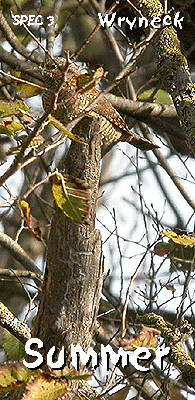 |
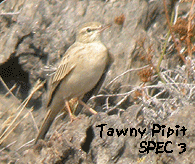 |
||||||||||||||||
Birding in the Cap de Creus: Summer (and Passage) |
|||||||||||||||||
A particular wooded ravine on the edge of Spain's Cap de Creus Natural Park has become one of my favourite bird watching spots in Catalonia and is where I always start my birding tours.Here one can gorge oneself on an early morning choral symphony the like of which I haven't heard anywhere else in Europe. Nightingale, Golden Oriole, Woodlark and a host of leaf and scrub warblers like the huge Orphean Warbler number amongst the dozens of particpants.The Kestrel-like squeal of a Wryneck may manage to tempt you away, allowing plenty of time to enjoy Cory's Shearwater, Black-eared Wheatear, Ortolan Bunting, Red-rumped Swallow and Bonelli's Eagle. |
|||||||||||||||||
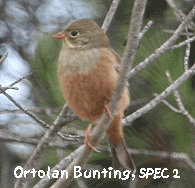 |
|||||||||||||||||
“Just a quick note to thank you for a nice day in the field. You certainly nailed some good birding spots and id’d many species new to me that I would have missed or been totally unable to make out.
|
 |
||||||||||||||||
| Woodchat Shrike (2) (nt) Spotless Starling (4) Ortolan Bunting (2) Winter (and Passage) : Red-throated Diver Key : SPEC 1 (1) |
|||||||||||||||||
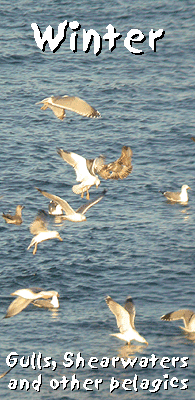 |
|||||||||||||||||
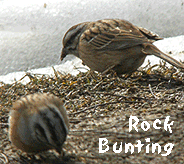 |
Birding in the Cap de Creus: Winter (and Passage) |
||||||||||||||||
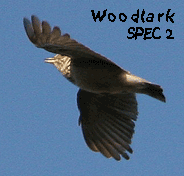 |
Birders wanting to see Europe's endemic Balearic Shearwater need only take a birding trip to Spain's eastern coastline, where they're present all year round. And in winter, when they 'swap places' and far out-number their Yelkouan cousins, they're difficult to miss.Several thousand can form rafts all along the coast, but concentrate at the Cap de Creus, where they mix it up with Gannet, Razorbill, gulls, terns and the odd diver.Buntings, finches, pipits and larks also form winter flocks that render them easy to find but wintering Alpine Accentor and Wallcreeper demand a little more effort . |
||||||||||||||||
| Spain birding: Cap de Creus: Winter itinerary | |||||||||||||||||
"We saw many birds we would never have spotted on our own and you provided us with many fascinating facts about the wildlife of the area. We will recommend your guiding service to our birding friends."
|
|||||||||||||||||
 |
|||||||||||||||||
The Nature of the Cap de Creus... a personal overview |
Migrant passerines too, have reason to be grateful for its assistance but, if it turns to tramuntana, they seek shelter from its cold bite in the patches of cork oak, a tree surviving on the Cap de Creus in part due to its resistence to fire.This third element is mainly induced by man as farmers, perhaps rashly, burn back tracts of land to try to preserve and expand grazing pasture. Once done though it provides habitat for Rock and Ortolan Bunting, Black and Black-eared Wheatears, Wood and Thekla Lark and the Tawny Pipit.Warblers too capitalise on the regeneration process with Spectacled Warbler taking residence during the 'grassy with scattered bushes' phase, Dartford and Subalpine Warbler moving in when it turns to scrub and the Sardinian Warbler much later.But perhaps for the final word we should return to water, who's intricate rock carvings in ages past and present have provided homes for Wallcreeper, Alpine Accentor, Pallid and Alpine Swift and both the Rock and Blue Rock Thrush.The expression exposed to the elements has never been more true than of the Cap de Creus (the last glimpse of the Pyrenees before they plunge into the ocean) as the effects of wind, fire and water are clearly visible for all to see.They shape everything. From the oddly-formed plants and trees sculptured by the hands of the tramuntana, or northwind, to the jagged cliffs and islands honed by the relentless action of the ocean.And then there's the birdlife.Any place that juts into the sea as if striving to justify the title 'most easterly point of Spain', is clearly going to be a good spot for seabirds, particularly if the llevante, or eastwind, is blowing them coastbound.And, at the right time of year, you can actually put down your binoculars and revel at the sight of Cory's, Balearic and Yelkouan Shearwaters all floating on a cushion of air just a few metres below you.This same wind of course carries through migrating Kites, Eagles and Honey Buzzard, all of which also depend on its power - like the resident Bonelli's Eagle - for hunting. |
||||||||||||||||
Six Shearwaters of the Cap de Creus |
The Mediterranean Shearwater was split-off from the Manx Shearwater in about 1990, rendering records of the latter unreliable, and then divided into Balaeric Shearwater and Yelkouan Shearwater around 1998.'Shearing' on stiff, flat wings held at 90º to the body with side-to-side dips just above the water is typical of most Shearwaters so it won't help you to separate them.Instead look for the diagnostic black line in the armpit of the Yelkouan, which also has a well-defined contrast between the very darkof its upper and white of its lower parts. It's also more compact than the Balearic, which has dirty-white lowers, with a smaller head, shorter neck and shorter, wider wings.The larger Cory's Shearwater also breeds in the Mediterranean and can be seen gliding with bowed wings, held slightly back, from February to November.The Great Shearwater and Sooty Shearwater are vagrants, rarely occuring on the return leg of their circular migration, of up to 14000km, from the Southern Hemisphere. |
||||||||||||||||
Cap de Creus Links : |
Roses Tourism/Cap de Creus |  |
|||||||||||||||
| Spain Info/Cap de Creus | |||||||||||||||||
| Costa Brava.com/Cap de Creus | |||||||||||||||||
| Zac Hinchcliffe's Blog (recommended) | |||||||||||||||||
| Mas Jonquer (Accommodation in the Emporda) | |||||||||||||||||
|
|||||||||||||||||

